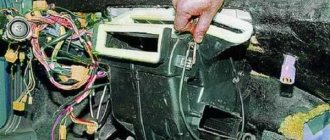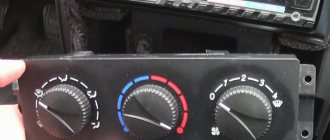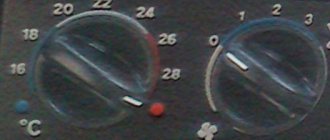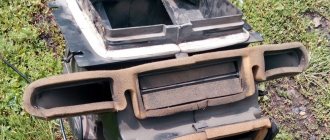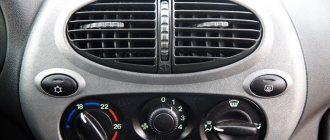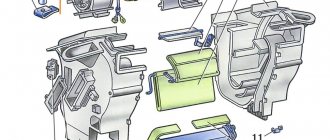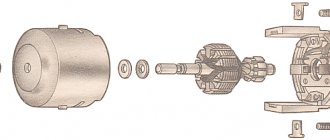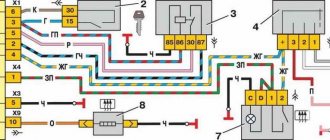In winter, at 25 degrees below zero, many owners of VAZ 2110 cars and their families notice one important problem in their cars - the interior heater heats very poorly. The reason lies in the ill-conceived design of the stove. The stove itself consists of two separate and completely different systems.
- The first system is an air heating unit. It consists of a heater radiator, air ducts with a regulation unit and a cabin filter.
- The second is the temperature control system.
- In addition, there is also a controller for the heater control unit.
In the interior of the VAZ 2110 you can quite often see that the heater simply does not respond to the temperature regulator. The answer immediately suggests itself - one of the elements of the system has simply failed. We start looking for him.
Problem with standard air ducts
Standard air duct
If the stove on a VAZ 2110 blows cold air, but at the same time it itself is heated to a temperature of 90 degrees, then the reason is hidden in the standard air ducts. Most likely, they are either damaged or have fallen off from the stove itself. And to get to them you will have to disassemble and remove the entire panel. If you still cannot restore them, you can simply replace them with corrugated hoses purchased from building materials and install them. And seal all joints tightly and thoroughly with polyurethane foam or modelin.
How to protect the pump from malfunction
It is advisable to always maintain the required volume of coolant water in the pipes. Otherwise, the pump will wear out, both in case of excess water volume and in case of insufficient water volume.
To be on the safe side and avoid breakdowns of fairly expensive pumping equipment, it is recommended to adhere to some basic rules for operating equipment of this type:
- Do not allow the pump to turn on without coolant in the closed circuit. That is, if there is no water in the heating system pipes, then you should not “torture” the pump. This will cause your equipment to break down quickly.
- It is advisable to always maintain the required volume of coolant water in the pipes. Otherwise, the pump will wear out, both in case of excess water volume and in case of insufficient water volume. For example, if a pump can distill an amount of water from 5 to 105 liters, then the need to work with volumes from 3 to 103 liters will greatly wear out the working components of the unit, which will lead to its failure.
- In case of prolonged downtime of the pump (during the low heating season), it is necessary to run the unit in the operating position for at least 15 minutes once a month. This will avoid oxidation of all movable elements of the pump unit.
- Try not to exceed the coolant temperature above 65 degrees Celsius. A higher rate will negatively affect the working and movable parts of the structure.
- In this case, check the pump housing for leaks more often. If there is even the slightest leak somewhere, you should immediately identify the malfunction and carry out maintenance on the pump.
The heater radiator is clogged
Radiator of the VAZ 2110 stove
If the stove on the VAZ 2110 blows cold air, then there is only one reason - the stove radiator is clogged. If the engine is cooled with water, then rust can form in the radiator, and at high temperatures, scale can also form. Small pipes in the radiator can become clogged if you (accidentally) mix antifreeze with antifreeze, this mixture will simply curdle. In addition, some short-sighted car enthusiasts add a special radiator sealant to the coolant, which also clogs the radiators from the inside. It's quite easy to check. You need to warm up the engine to a temperature of 90 degrees, turn on the heater and check the inlet and outlet pipes of the heater by touch. If the temperature on them is different, then the radiator is simply clogged and must be replaced. But the process of replacing it is quite labor-intensive.
What to do if the heater motor does not work
Sometimes the problem with very low interior temperatures is due to the fact that the heater motor is not performing its functions. You can detect its failure as follows:
- start the car engine;
- Using the heating system control unit, we switch its operating modes;
- If, when switching, the sound of the motor and its rotation speed changes, then everything is in order.
Otherwise, you will need to perform diagnostics of the entire system, which usually indicates the following reasons for motor failure:
- due to intense loads the fuse has failed;
- The heater operating mode switch is broken;
- contacts in the system have oxidized;
- the wires connecting the heating system to the on-board power supply network are damaged;
- The motor itself burned out.
The most difficult task is to eliminate the last fault, since in this case you will need to install a new electric motor.
This procedure must be performed strictly in the following sequence:
- unscrew the decorative trim located directly in the car interior, on the driver’s side;
- disconnect the wire through which voltage is supplied to the electric motor;
- remove the wiper arms that prevent access to the heater motor;
- remove the seal located immediately under the wiper panel;
- dismantle the upper protective casing of the electric motor and disconnect the power wires;
- divide the electric motor into two parts and carefully remove it;
- We mount the working part and carry out the assembly in the reverse order.
Replacing a heater motor is a rather complicated procedure, so if you do not have the relevant experience, it makes sense to contact a car service center
If this is not possible, try to perform all operations with extreme caution so as not to damage parts located in the immediate vicinity of the unit
The thermostat has failed
Thermostat VAZ 2110
The most common reason why the stove on the VAZ 2110 does not heat with hot air is the thermostat. It just starts to stick in the upper or lower position over time. If this happens, then you just need to replace it. But the same situation can happen to a new one. So what should we do then, change it again? There is a proven way to bring a stuck thermostat back to life.
To do this, you will need to park the car on a slight slope. In this case, the front wheels must be 25–35 cm higher than the rear wheels. The engine must be running. You need to open the hood and prepare a small wooden (precisely wooden, to avoid damaging the thermostat) stick, or the handle of a shovel. Now, once you get behind the wheel, you need to change the gas 2-3 times. Immediately go out and tap the thermostat with the butt of a stick. After this, touch all incoming and outgoing pipes near the thermostat. Such manipulations need to be carried out 3 – 5 times, after which the thermostat will work like new again.
Other causes of failure
- In addition to the dampers, the fan often starts to malfunction. Possessing as many as four operating modes, its malfunctions can be very different. The first thing you need to do is look at the fuse (F7). If the fan refuses to work at all, most likely this is the problem.
- There are times when the above-mentioned unit performs poorly or even stops rotating at low speeds. This problem is more complicated, since, most likely, it is associated with the burnout of additional resistance. This is not that difficult to fix, but the problem will be the path to solving such a problem. The broken part can only be reached through the engine compartment.
- In addition, it is in the engine compartment that you often need to look for the reasons why only warm air comes out, while the adjustment is at the “maximum” position.
It's all about adjusting and supplying air inside the car body. The climatic conditions outside the car are also important to consider. But it’s better to leave all the troubles with the engine compartment in the hands of the service station. Repairing heaters, stoves, and air circulation in this machine is very difficult, so independent work must be carried out with a great understanding of responsibility and good experience in machine repairs.
Fan repair (step by step)
The disassembly technology is very simple, but proceed carefully. Since electric motor failure lies in the wear of bearings and graphite brushes, let’s consider how to replace these elements:
- Let's disassemble the electric motor. To do this, first remove the impeller, and then the two spring clamps of the motor support.
- We remove the support.
- Unscrew the screws securing the brush assembly and remove it.
- Carefully knock out the rotor.
- We clean the elements from dust and dirt.
- From the inside of the stator, carefully bend the edges of the plate holding the bearing.
- We knock out the bearing and install a new one in its place (for replacement you need bearing No. 609).
- We bend the edges of the plate back.
- We inspect the condition of the collector plates on the rotor and, if necessary, sand them with sandpaper (fine-grained).
- We replace the worn brushes with new ones (we solder the wires of the worn ones, and in their place we solder the wires of the new elements).
- We bend the stops of the brush springs (this will allow you to easily install the brush assembly in place).
- We put the rotor in place.
- We install and fix the brush assembly, having previously seated the brushes in their seats.
- We install brush springs into the holes that covered the stops and bend the stops back.
- Install the fan support and impeller.
- We install the repaired fan on the car.
Heating system VAZ-2114
The VAZ-2114 interior heater consists of the following elements:
- radiator with pipes;
- supply shut-off valve;
- frame;
- air ducts;
- dampers;
- fan;
- Control block.
Heating of the air supplied to the cabin is carried out by passing the air flow through the honeycombs of a heat exchanger - a radiator, through which coolant heated by the engine circulates.
The VAZ-2114 heater has the ability to shut off the supply of antifreeze to the heater radiator, so the heating system is turned off (for the summer period). The supply is stopped using a tap embedded in the coolant supply pipe to the heater radiator.
The radiator is installed in the heater housing. In addition to housing the component elements of the stove, the housing prevents the dispersion of air flow and directs its movement.
The heater body is connected to air ducts, with the help of which it supplies heated air flow to the areas of the windshield and side windows, to the middle of the cabin, to the feet of the driver and front passenger. To adjust the direction of air flow, deflectors are installed at the ends of the air ducts that supply heat to the side windows and into the middle of the cabin.
The distribution of air flow across zones is ensured by dampers installed in the housing. The design of the VAZ 21-14 stove uses three dampers:
- Stove control damper. It redirects the air flow through the radiator (the stove is operating) or bypassing it (the system is operating in interior ventilation mode).
- Damper for supplying flow to the windshield area.
- Damper for redirecting warm air to the footwell area or to the side windows and into the passenger compartment.
Thanks to the dampers and the heater tap, the driver activates the interior heating system, controls the air flow, choosing which zone it should be supplied to.
The fan included in the heater design creates an air flow. Thanks to the power supply circuit of the fan electric motor being equipped with rheostats, the unit received three operating modes in which the fan rotates at different speeds.
Unlike the heating systems of cars of the classic family - VAZ-2101-2107, the fan in the VAZ-2114 forces air into the heater body, rather than drawing it in, which increases the efficiency of air supply. Therefore, this unit was installed not inside the housing, but on it. Access to the fan has become easier, since on the VAZ-2114 it is located in the engine compartment, in a niche near the engine shield.
How does the VAZ 2110 interior temperature sensor work?
- Registration
- Entrance
- To the beginning of the forum
- Forum Rules
- Old design
- FAQ
- Search
- Users
. Said done, we disassemble the sensor, look, there is a thermistor approximately equal to 1200 ohms, a resistor of approximately 1500 ohms is connected in series with it, then a 30 ohm “tuning” resistor in series, then a jumper and EVERYTHING, then only the sensor terminals. We unsolder the jumper, solder in a 100 ohm resistor, put the sensor in place, check the operation of the system, etc. HERE IT IS, THE HARMFUL HAPPINESS OF THE TAZOVODA - the machine started working the way the designers intended. And in automatic mode it works as it should and in manual mode everything is tip top
okay, since you are so talented, tell me: why do I hear some squeaks and squeaks coming from this unit (well, where the temperature and speed of rotation of the fan are regulated) when I put it on heat? and why do I put it on the red dot - it’s hot, and just one point lower - it’s cold? By the way, on the side I have + - I didn’t see the manual adjustment, I have a block with the letter “A”.
I already had this. The variable resistor on the heater micromotor reducer is faulty. Not sold separately.. Replaced complete in 30 minutes. The SAUO unit does not understand what resistance is on the micromotor gearbox, i.e. what position is the damper in now (the tracks are worn out) and it’s going crazy. The flap moves back and forth. Price - 560 rubles. And what’s a shame is that the motor and gearbox are in good working order, but the resistor doesn’t cost a penny and it’s all a waste. Special respect to Vazu..
but I have a slightly different problem: 1. I put it on the red dot - it’s hot 2. I reduce it to 18 - it’s still hot 3. I remove it from the blue dot - it’s cold. 4. The cold continues until you turn to red again.
The variable resistor on the heater micromotor reducer is faulty. Not sold separately.. Replaced complete in 30 minutes.
Mouse 21113, tell me how you changed it, what did you take apart? Same crap!
How is this very resistor attached to the micromotor gearbox and is it really impossible to pick up anything from electronics stores (what kind of resistor is it, a non-standard one)?
voice
Article rating
Briefly about the design features of the stove on the VAZ-2112
Until the owner of a VAZ-2112 encounters a cold interior in winter, he may not realize that the stove of the entire tenth family has an important design feature - it is made in the form of two separate systems, in each of which a breakdown may occur or a design defect may appear. or a factory defect.
Heater design diagram.
- Firstly, the tens heater consists of an air heating unit itself. Everyone is familiar with this unit: heater radiator, air ducts with a regulation unit, cabin filter.
- Secondly, the car is equipped with an electronic temperature control system. Each of these elements can pose a potential threat to the microclimate in the cabin. Another element of the system is the heater control unit controller. We will check each of the elements, modify them if necessary, and bring the temperature in the cabin back to normal.
Rules for Car Maintenance
In order to operate the vehicle for as long as possible and without any complications or breakdowns, manufacturers indicate a certain frequency for replacing consumables. For each car brand, it may differ slightly, but we will give average parameters that most car owners should focus on:
- Fuel filter. Replacement is recommended every 30,000-50,000 km. Or, depending on the intensity of use of the machine, every 18-24 months.
- As a rule, auto mechanics recommend replacing the engine oil and oil filter at the same time. And this should be done every 10,000-15,000 km.
- The battery should be replaced after 3-5 years or after traveling 40,000-80,000 km.
- Changing the air filter is advisable after 30,000-50,000 km;
- The oil in the automatic transmission should be checked regularly (once every 2-3 weeks), and it will need to be replaced after 50,000-80,000 km or every 3-5 years.
- Spark plugs need to be replaced on average every 30,000-50,000 km.
- Timing belts or chains are replaced in case of mechanical wear. It is also necessary to observe the frequency of replacement every 50,000-120,000 km, depending on the make of the car.
- The coolant should be checked regularly (2 times a month) and changed every 40,000 km.
- Brake pads and brake fluid need to be replaced every 20,000-50,000 km, depending on the vehicle and the installed unit.
- The cabin filter should be changed 4-5 times a year.
- The amount of freon is replaced or supplemented at least once a year.
- Windshield wiper blades should be replaced every 10,000 km.
- The oil in the transfer case will require a complete change after 50,000-75,000 km.
- The power steering fluid should be updated after 100,000-150,000 km.
Advice from auto mechanics
To tune the VAZ heating system, its circuit diagram is studied. The system can be modified to block the air flow to the rear of the car using foam. The factory thermostat is also being replaced with an analogue one with 6 holes. In this case, the temperature in the cabin will remain longer, and the stove will heat better. Another way to modify the standard 2110 heating system is to install a plug for the deflector.
In order for the stove to serve longer, it is recommended to follow the rules of its operation.
If your car has air conditioning, it should only be turned on in wet weather. In winter, the stove turns on and directs the air onto your feet or onto the glass.
To ensure good operation of the heater, the nozzle is raised above the lining. Before starting the stove in winter, it is recommended to clean the glass from moisture.
Situations when the stove does not work on a VAZ 2110 are quite common. That’s why many people have to solve this problem. Some do this with the help of car service specialists, others do it with their own hands. Today we will talk about the first option.
Heater
Insulation
Sometimes hot air does not flow well to the feet and side windows. Although the stove works fine, for some reason my feet are cold, and the side windows are foggy. Even if you install a new corrugation, it is unlikely to help much.
It is also necessary to eliminate all the cracks so that the warm air does not fight with the cold air, but goes straight to the target. Everything on the panel needs to be sealed with anti-squeak, and in some places with polyurethane foam, which will not creak and will also help retain heat for a while.


